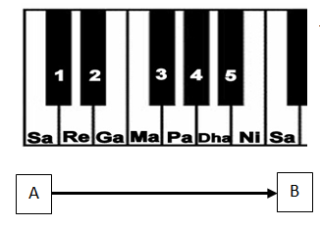After a good response from the last 2 articles; I am grateful to you all, I would like to share a lot more information about Indian classical music with my readers. Before sharing some new information let us revisit some things which we have discussed till now. In the 1st one I told you all about ragas and swaras and how the 7 swaras originated from the sounds of nature. In the second one you were told about the nature of swaras like vikrit and the Achal swara, the different key characteristics of ragas; which are the Aaroh, Avroh and the Pakad, and towards the end about gharanas and Yes…about the particular style of singing “the thumri”. In the end I asked all the readers to give a genuine feedback and to tell me if anyone of them are interested to know about some specific information that they would like to know through my post. One of my fast friends and an enthusiast reader Arpit Sarkar asked me about the concept of different scales, naturals, sharps and the flat notes. In spite of these all being purely practical aspects of music; I’ll try my best to explain each of these to you in theory.
Scales are a set of swaras (notes) which are arranged in an orderly pitch. A scale ordered in an increasing pitch is an ascending scale and one arranged in a decreasing pitch is a descending scale. For e.g. while going to from “Sa” to “Sa” from the lower “Sa to the upper “Sa” (from A to B in the picture) it is an ascending scale and while coming back to the lower “Sa” from the upper “Sa” (from B to A in the picture) it is a descending scale.
The different types scales in Indian classical music are-
- Heptatonic (Sampoorn)
- Hexatonic (Shadav)
- Pentatonic (Audhav)
- Tetratonic
There is another kind of scale where the ascending and the descending order of a raag is not fixed. These ragas are known as the vakr ragas. Raag Bhimpalsi is a vakr raga where the ascending has only 5 notes (SA ga MA PA ni SA)* and the descending of the same raga has 7 notes (SA ni DHA PA MA ga RE SA)*. The “jaati” (type) of this raga is “Audhav-Sampoorn” (5 while ascending and 7 while descending). Refer audio 1.
A raga is said to be a heptatonic raag if 7 swaras are being used in that raag. These are ragas which are known as the “sampoorn jaati ke raag”, in these ragas; all the notes in the octave are sung or played. Raag Kafi is a sampoorn raag. The ascending and the descending of this raga is “SA RE ga MA PA DHA ni SA”*, “SA ni DHA PA MA ga RE SA”*. The “jaati” of this raga is Sampoorn-Sampoorn (7 both ways). Refer audio 2.
A raga is said to be a hexatonic raga if 6 swaras are being used in that raga. These are ragas which are known as the “shadav jaati ke raag”, in these ragas; 6 notes are sung or played. Raag Kedar is a Shadav raag. The ascending and descending of this raga is “SA RE MA PA ma PA DHA NI SA”*, SA NI DHA PA ma PA DHA PA ma SA RE SA”*. Refer audio 3.
The third type of scale is he Audhav scale where 5 swaras are used in a raga. These ragas are known as the “Audhav jaati ke raag”, only 5 notes are played or sung in this raga. Raag Durga is an Audhav raga. The ascending of this raga is “SA RE MA PA DHA SA”*,”SA DHA PA MA RE SA”*. The “jaati” of this raga is Audhav-Audhav (5 both ways). Refer audio 4.
The last type of scale is the tetratonic scale wherein only 4 swaras are used in a raga. This scale is not at all used in the Indian classical music. It is used only in tribal songs of Odisha and in other tribal areas of India.
I hope this all was interesting and easy to understand. I could only cover the concept of the different types of scales in this article and not the other aspects as asked. But surely this was a heavy dose in itself and I am going to explain each and everything slowly but steadily. If anyone has any doubts or wants to give a feedback; please feel free to comment.
*In the above notations of the swaras of different ragas, some swaras are written in capitals while some in small letter format, I will tell you the meaning of that also in my upcoming article.



































